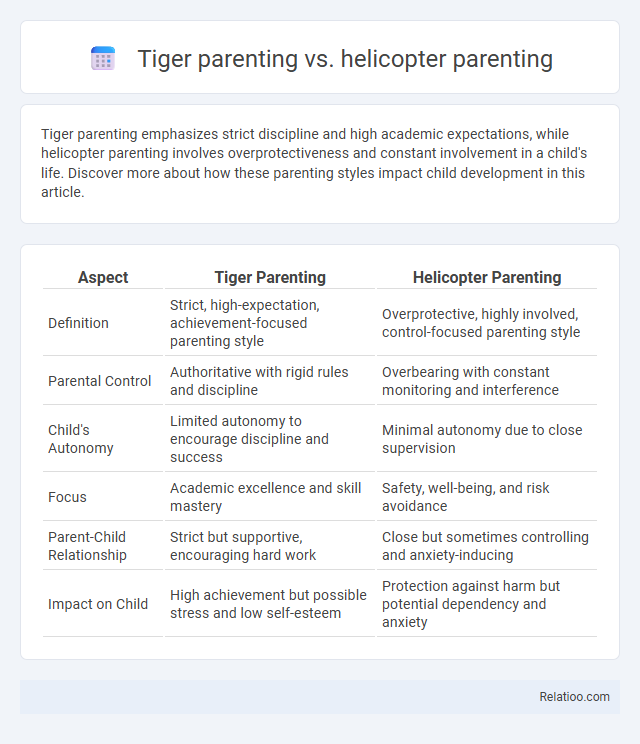Tiger parenting emphasizes strict discipline and high academic expectations, while helicopter parenting involves overprotectiveness and constant involvement in a child's life. Discover more about how these parenting styles impact child development in this article.
Table of Comparison
| Aspect | Tiger Parenting | Helicopter Parenting |
|---|---|---|
| Definition | Strict, high-expectation, achievement-focused parenting style | Overprotective, highly involved, control-focused parenting style |
| Parental Control | Authoritative with rigid rules and discipline | Overbearing with constant monitoring and interference |
| Child's Autonomy | Limited autonomy to encourage discipline and success | Minimal autonomy due to close supervision |
| Focus | Academic excellence and skill mastery | Safety, well-being, and risk avoidance |
| Parent-Child Relationship | Strict but supportive, encouraging hard work | Close but sometimes controlling and anxiety-inducing |
| Impact on Child | High achievement but possible stress and low self-esteem | Protection against harm but potential dependency and anxiety |
Understanding Tiger Parenting: Key Characteristics
Tiger parenting is characterized by strict discipline, high expectations, and an intense focus on academic achievement and skill development, often pushing children to excel through rigorous schedules and close supervision. Unlike helicopter parenting, which centers on overprotectiveness and constant monitoring to shield children from failure, tiger parenting emphasizes strict rules and the belief that hard work and perseverance lead to success. Understanding these key characteristics reveals tiger parenting's emphasis on self-discipline, resilience, and striving for excellence, often at the expense of autonomy and emotional expression.
Defining Helicopter Parenting: Main Traits
Helicopter parenting is characterized by over-involvement in a child's life, where parents closely monitor and control their child's experiences to prevent failure or harm, often leading to reduced child autonomy and decision-making skills. This parenting style contrasts with tiger parenting, which emphasizes strict discipline and high expectations for academic and personal achievement. Your understanding of these traits can help balance supportive guidance with fostering independence in your child's development.
Core Differences Between Tiger and Helicopter Parenting
Tiger parenting emphasizes strict discipline, high expectations, and academic excellence, often pushing children to achieve specific goals. Helicopter parenting involves over-involvement in a child's life, focusing on protecting and managing the child's experiences to prevent failure or harm. The core difference lies in tiger parents demanding achievement through rigorous control, while helicopter parents prioritize constant supervision and intervention to shield their children.
Impact on Children’s Academic Performance
Tiger parenting emphasizes strict discipline and high expectations, often leading to improved academic performance due to structured study routines and parental involvement. Helicopter parenting involves excessive oversight and intervention, which may undermine Your child's independence and problem-solving skills, potentially causing anxiety and reduced academic motivation. Balanced parenting that combines support with autonomy fosters a healthier learning environment, promoting both academic success and emotional well-being.
Effects on Emotional and Social Development
Tiger parenting, characterized by high expectations and strict discipline, often leads to academic success but may cause increased anxiety and reduced social adaptability in children. Helicopter parenting, marked by excessive involvement and protection, can hinder your child's emotional resilience and independence, resulting in lower self-confidence and difficulty managing social relationships. Balancing authoritative guidance with emotional support is crucial for fostering healthy emotional and social development.
Cultural Influences on Parenting Styles
Tiger parenting, characterized by strict discipline and high expectations, often stems from East Asian cultural values emphasizing academic excellence and family honor. Helicopter parenting, prevalent in Western societies, reflects cultural focuses on child safety and emotional support, with parents closely monitoring every aspect of their child's life. Cultural influences shape these parenting styles by embedding societal priorities such as achievement in tiger parenting or protection in helicopter parenting into daily family interactions.
Long-term Outcomes for Children
Tiger parenting emphasizes high academic achievement and discipline, often leading to strong work ethics but potential stress and reduced creativity in children. Helicopter parenting involves over-involvement and constant supervision, which can hinder the development of independence and problem-solving skills in the long term. In contrast, balanced parenting strategies that combine support with autonomy tend to foster resilience, emotional well-being, and sustained academic success in children over time.
Parental Motivations and Expectations
Tiger parenting emphasizes strict discipline and high academic achievement driven by a belief in cultivating excellence through rigorous effort and control. Helicopter parenting centers on intense involvement and protection, motivated by parental anxiety to prevent failure and ensure safety. Both styles set high expectations, but tiger parents demand independence and resilience, while helicopter parents prioritize constant oversight and immediate problem-solving.
Advantages and Disadvantages of Each Style
Tiger parenting emphasizes high academic achievement and discipline, fostering strong work ethics but often causing stress and reduced emotional connection. Helicopter parenting involves close monitoring and intervention in children's lives, promoting safety and support but potentially hindering independence and problem-solving skills. Balanced parenting combines firm expectations with emotional warmth, encouraging both competence and resilience while minimizing the drawbacks of overly strict or overly controlling approaches.
Striking a Healthy Parenting Balance
Striking a healthy parenting balance involves recognizing the intense discipline of tiger parenting, which emphasizes high academic and behavioral expectations, alongside the overprotective tendencies of helicopter parenting, which focuses on constant oversight and intervention in a child's life. Effective parenting blends tiger parenting's drive for achievement with helicopter parenting's attentiveness while promoting autonomy and emotional resilience in children. Research highlights that balanced parenting styles foster self-discipline, confidence, and independent problem-solving skills crucial for long-term success.

Infographic: Tiger parenting vs Helicopter parenting
 relatioo.com
relatioo.com